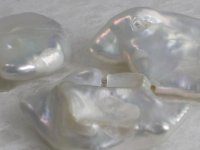Maeshori has a lot of meanings now. It is a Japanese word that literally means before (mae) treatment (shori). It is a treatment used on all akoya, freshwater and some South Sea. Maeshori treatments vary from factory to factory, but Karin is more or less correct in what it does. It tightens the nacre and pulls moisture out, which will enhance the luster but also make the nacre more brittle. In freshwater, pearls that have been over-treated will turn chalky in short order.
Maeshori with South Sea pearls is a very common treatment in Japan. It makes the pearls whiter, brighter, and more salable. It isn't a necessary treatment, in my opinion. Joseph Taylor from Atlas does sell his treated, and his pearls are beautiful. Other producers, like Kakuda growing in Indonesia, universally treat their South Sea, but they also disclose the maeshori.

